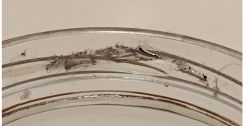FAQ
TL;DR: Galinstan melts at −19 °C and "readily wets glass"—if your spill smears and sticks to glass, it’s likely mercury‑free. This FAQ helps homeowners identify broken‑thermometer fluid and clean up safely. [“Galinstan”]
Why it matters: Quick identification guides safe cleanup and reduces exposure risk for you and your family.
Quick Facts
- Mercury is liquid at room temp (mp −38.83 °C) and beads up without wetting glass. [“Mercury (element)”]
- Galinstan (Ga‑In‑Sn) used in mercury‑free thermometers melts near −19 °C and readily wets glass. [“Galinstan”]
- Gallium melts at 29.76 °C, so it’s usually solid indoors; molten gallium also wets glass. [“Gallium”]
- A fever thermometer typically contains about 0.5–3 g of mercury when present. [“WHO: Mercury and health”]
- EPA cleanup guidance: ventilate, pick up with stiff paper and tape, and never vacuum or sweep. [“Mercury Spills (EPA)”]
How can I tell from appearance if it’s mercury or a gallium-based alloy?
Look for wetting on glass. Galinstan “readily wets glass,” leaving a smeared, adherent film rather than round beads. It stays liquid at room temperature because its melting point is about −19 °C. These visual cues strongly indicate a mercury‑free gallium‑based alloy. [“Galinstan”]
Does mercury stick to glass or bead up?
Mercury has very high surface tension. It forms shiny, mobile beads and does not wet or stick to clean glass. Beads coalesce and roll, especially on smooth, sloped surfaces. This behavior is a key visual identifier for elemental mercury. [“Mercury (element)”]
Is galinstan (or gallium) toxic if I touched it?
Galinstan is designed as a mercury substitute and is considered non‑toxic. Wash skin with soap and water after contact. Avoid ingestion and keep it away from aluminum surfaces. It can leave gray stains due to surface wetting and oxide formation. “Non‑toxic” does not mean risk‑free, so minimize unnecessary contact. [“Galinstan”]
What should I do immediately after a suspected mercury spill?
Do this:
- Ventilate: open windows and close interior doors; leave the area for 10–15 minutes.
- Collect: use stiff paper or cardboard to gather beads; use sticky tape for tiny droplets.
- Contain: seal debris in an airtight jar or zip bag; label for hazardous waste.
Never use a vacuum. [“Mercury Spills (EPA)”]
Are mercury vapors dangerous at room temperature?
Yes. Elemental mercury slowly evaporates at room temperature, and about 80% of inhaled vapor is absorbed in the lungs. Small indoor spills can raise air levels, especially in poorly ventilated spaces and cracks. Limit exposure by prompt, proper cleanup and ventilation. [“ATSDR ToxFAQs: Mercury”]
Some liquid fell into floor cracks—what now?
Treat cracks as contaminated if mercury is possible. Ventilate, gently nudge beads together with paper, and use sticky tape to lift residues. Seal all cleanup material in airtight containers. Do not vacuum. Contact local environmental or hazardous‑waste services for disposal advice. [“Mercury Spills (EPA)”]
Is gallium solid at room temperature?
Yes. Gallium’s melting point is 29.76 °C, so it is usually solid indoors. It can melt in a warm hand or hot room. When molten, it wets glass and many surfaces, which can make spills look smeared rather than beaded. [“Gallium”]
Do modern glass thermometers use galinstan instead of mercury?
Many mercury‑free clinical thermometers use Galinstan, a gallium‑indium‑tin alloy. It is non‑toxic, remains liquid well below room temperature, and readily wets glass. These properties make it a practical mercury replacement in capillary thermometers. [“Galinstan”]
Can I vacuum or sweep a mercury spill?
No. “Never use a vacuum” because it disperses mercury into tiny droplets and increases vapor release. Sweeping also breaks droplets into smaller beads that are harder to recover. Use stiff paper, eyedroppers, and tape per spill guidance instead. [“Mercury Spills (EPA)”]
How do I dispose of the broken thermometer and cleanup waste?
Seal glass, beads, and cleanup materials in an airtight container or zip bag. Label it clearly. Take it to a household hazardous‑waste facility or follow local authority instructions. Do not place mercury wastes in regular trash or drains. [“Mercury Spills (EPA)”]
Could the broken thermometer be alcohol-based instead of metal?
Yes. Alcohol thermometers use dyed liquids (often red or blue) and contain no silvery metal droplets. If you see colored liquid without metallic shine or beads, it is likely an alcohol thermometer, which does not release mercury vapor. [“Alcohol thermometer”]
Can gallium-based alloys damage aluminum or electronics?
Yes. Galinstan and liquid gallium can corrode and embrittle aluminum and some other metals. Keep these alloys away from aluminum housings, heatsinks, and foils during cleanup and storage. Use glass or compatible plastics for containers. [“Galinstan”]
When should I call professionals or local authorities?
Call if mercury spreads over a wide area, enters porous materials or HVAC, or if you cannot collect all beads. Also call for spills larger than a thermometer’s contents, or when vulnerable people are present. Follow local health or environmental agency guidance. [“Mercury Spills (EPA)”]




